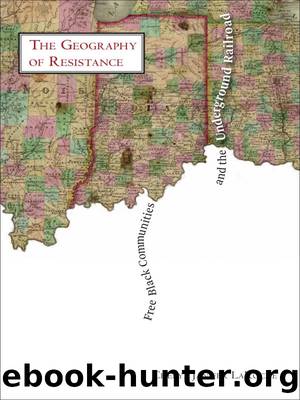Free Black Communities and the Underground Railroad by Cheryl Janifer LaRoche

Author:Cheryl Janifer LaRoche
Language: eng
Format: epub
Publisher: University of Illinois Press
Published: 2014-10-15T00:00:00+00:00
White Philanthropic Abolitionism and Quaker Settlements
Free or newly freed Blacks migrated out of the South with Quaker or Presbyterian abolitionists, former slaveholders, or White philanthropists in the first decades of the nineteenth century. Together, they established numerous midwestern communities. As early as 1773, Thomas Jefferson advocated establishing colonies for free Blacks. Along with George Washington, Jefferson believed Black colonies should be a precondition for emancipation. Between 1819 and the 1860s, White private individuals and organizations formed or aided communal efforts involving 3,500 to 5,000 Blacks. The communities extended from Pennsylvania to the states of the Old Northwest, to Virginia, Tennessee, and South Carolina, to British Columbia and Ontario, Canada.38 William and Jane Pease overstate the impetus for the formation of organized Black settlements for newly emancipated slaves. They claim that direction came âentirely from White people strongly imbued with the simplest kind of philanthropic zeal.â39 Such a view negates the importance of African American initiatives at places such as New Philadelphia or the Roberts settlement in Indiana.
Although it took Quakers more than a century to reckon with their own slaveholding past, once they realized the implications of their ungodly behavior, the sect was a forceful leader in manumissions and in establishing settlements for freed men and women. Driven more by conscience than experience, experimental communities in Ohio, settlements in Indiana and settlements in Illinois reflect the Quaker commitment to bringing freedom to an enslaved population. Other religious-minded abolitionists such as the New School Presbyterians associated with Miller Grove also purchased land for settlements. At Miller Grove, Lick Creek, and Poke Patch, plans went beyond simple emancipation and resettlement; the communities included both free people of color and their former oppressors, or the former slaveholders lived nearby.
Download
This site does not store any files on its server. We only index and link to content provided by other sites. Please contact the content providers to delete copyright contents if any and email us, we'll remove relevant links or contents immediately.
| General | Discrimination & Racism |
Nudge - Improving Decisions about Health, Wealth, and Happiness by Thaler Sunstein(7261)
iGen by Jean M. Twenge(5166)
The Fire Next Time by James Baldwin(5025)
Adulting by Kelly Williams Brown(4241)
The Hacking of the American Mind by Robert H. Lustig(4094)
The Sports Rules Book by Human Kinetics(4081)
The Ethical Slut by Janet W. Hardy(4042)
Captivate by Vanessa Van Edwards(3732)
Mummy Knew by Lisa James(3523)
In a Sunburned Country by Bill Bryson(3376)
The Worm at the Core by Sheldon Solomon(3328)
Ants Among Elephants by Sujatha Gidla(3282)
Suicide: A Study in Sociology by Emile Durkheim(2908)
The Slow Fix: Solve Problems, Work Smarter, and Live Better In a World Addicted to Speed by Carl Honore(2843)
The 48 laws of power by Robert Greene & Joost Elffers(2818)
Humans of New York by Brandon Stanton(2694)
Handbook of Forensic Sociology and Psychology by Stephen J. Morewitz & Mark L. Goldstein(2606)
The Happy Hooker by Xaviera Hollander(2586)
The Tipping Point by Malcolm Gladwell(2565)
